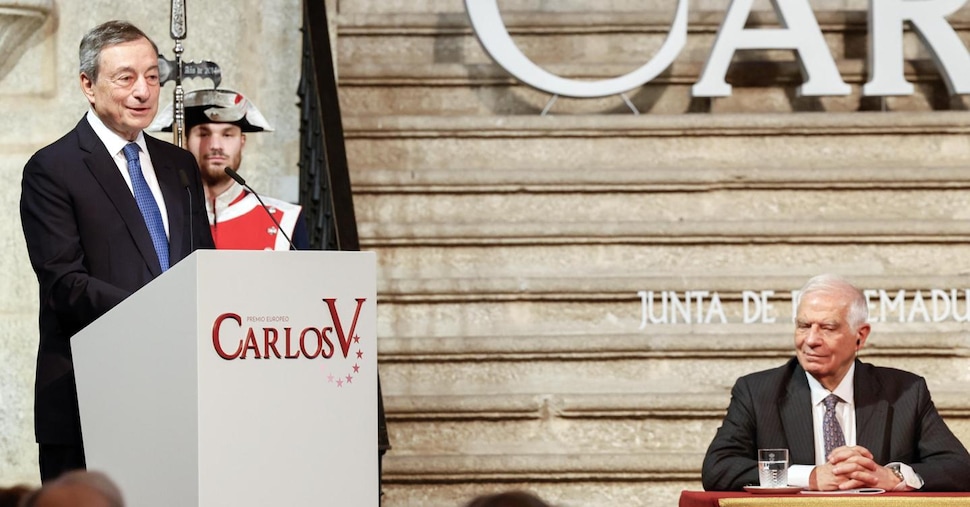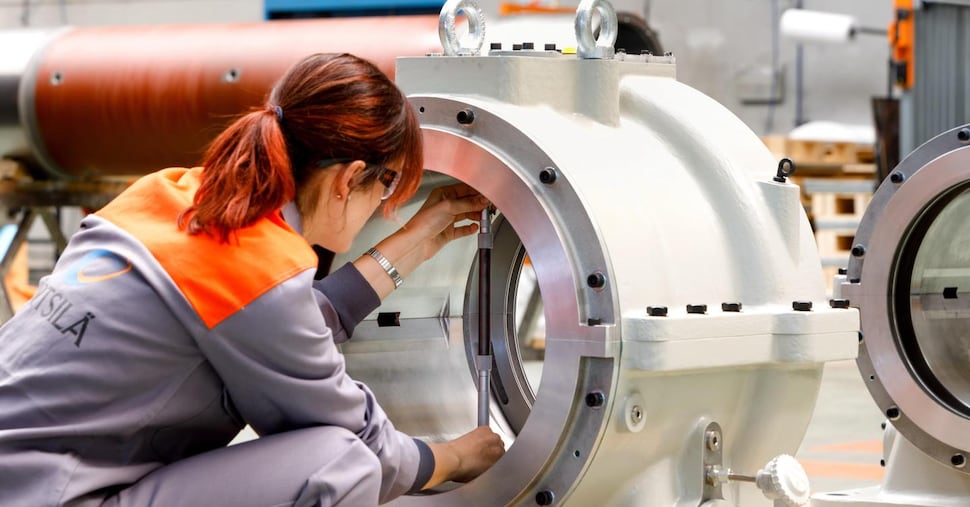An industrial strategy for Europe
Address by Mario Draghi on the occasion of receiving the Carlos V European Award
Monastery of San Jerónimo de Yuste, 14 June 2024
Your Majesty.
President of the Regional Government of Extremadura.
President of the Assembly of Extremadura.
President of the Board of Trustees of the European and Ibero-American Academy of Yuste Foundation.
Minister of Foreign Affairs, European Union, and Cooperation.
Minister of Economy, Trade, and Business.
High Representative of the European Union for Foreign Affairs and Security Policy and Vice-President of the European Commission.
Ambassadors.
Vice President of the European Central Bank.
Bishop of Plasencia and friars of the Monastery Community.
Academics.
Authorities.
Honoured guests and friends.
I would like to begin by thanking His Majesty King Felipe VI for his exceptionally kind words. It is a great honour for me to receive the Carlos V European Award – and in such a historic setting.
This monastery, as the final resting place of the Carlos V, harks back to the long and rich history of Europe, as well as the centuries long process of building European unity.
Over the years, our continent has grown older, wealthier and closer, with a single market of 445 million consumers. But today we face fundamental questions over our future.
As our societies age, demands on our social model are increasing. At the same time, for Europeans maintaining high levels of social protection and redistribution is non-negotiable.
We are also facing new needs: adjusting to rapid technological change, increasing defence capability and carrying out the green transition.
And all the while, the previous paradigm which sustained our shared objectives is disappearing. The era of imported gas from Russia and open world trade is fading.
So, if we are to cope with all these changes, we will need to grow faster and better. And the main way to achieve faster growth is to increase our productivity.
Europe’s productivity growth has been slowing for some time. Since the early 2000s, per capita GDP at PPP (i.e. adjusted for internal prices) has been about one third lower than the US – and around 70% of this gap is explained by lower productivity.
The difference in productivity growth between the two economies is predominantly down to the tech sector and digitalisation more generally. If we were to exclude the tech sector, EU productivity growth over the past twenty years would be at par with that of the US.
But the gap could widen further with the rapid development and diffusion of artificial intelligence. Around 70% of foundational AI models are being developed in the US and just three US companies account for 65% of the global cloud computing market.
A series of policy actions are necessary to start closing this gap.
First of all, we need to reduce the price of energy. Industrial users of energy in Europe currently face a major competitive disadvantage compared with their US peers, with prices that are 2-3 times higher for electricity.
This price differential is primarily driven by our delay in installing new clean energy capacity and lack of natural resources, as well as our limited collective bargaining power despite being the world’s largest buyer of natural gas. But it also caused by fundamental issues with our internal energy market.
We suffer from slow and suboptimal infrastructure investment, both for renewables and grids. Underdeveloped grids imply that we cannot match energy demand even when there are surpluses in some parts of the EU.
We have market rules that do not fully decouple the price of renewable and nuclear energy from higher and more volatile fossil fuel prices, preventing industries and households from capturing the full benefits of clean energy in their bills. And over time energy taxation has become an important source of budget revenues, contributing to higher retail prices.
These high prices are leading to lower investment in Europe: last year, around 60% of European companies said energy prices were a major impediment to investment – more than 20 percentage points higher than the response of US companies.
And they also stand in the way of making production more digital, as AI is highly energy intensive. The International Energy Agency forecasts that electricity consumed by data centres will double globally by 2026, an increase roughly equal to the whole electricity demand of Germany.
So, higher productivity hinges on building a genuine European energy market.
Next, we need to re-think the innovation environment in Europe. As a share of GDP, European firms spend about half as much as their US peers on research and innovation (R&I), leading to an investment gap of around €270 billion every year.
The pipeline from fundamental research into commercialisation of ideas is also much weaker. There are no European innovation clusters in the top 10 globally and our universities struggle to retain top talent.
The EU therefore needs to set R&I as a collective priority. A common agenda could include reinforced support for fundamental research, centred on academic excellence, an increased focus on disruptive innovation, and a greater capacity to support start-ups and help them grow.
We also need to create the conditions for innovation to diffuse faster through the economy. The key factors here are enabling European firms to reach optimal scale, so that they have the capacity to invest in new technology, and reskilling European workers, so that they can master this technology.
Achieving scale requires removing the remaining barriers to cross-border activity within the Single Market, especially those that stand in the way of digital diffusion. As an example, cloud computing in public administration needs to be framed by a single set of rules.
And competition policy needs to facilitate scale by weighting innovation and resiliency criteria in tune with the evolving market and geopolitical contexts – while avoiding excessive market concentration that raises consumer prices and lowers quality of service.
At the same time, reskilling our workforce will require strengthening education and training systems, encouraging adult learning and facilitating the entry of highly skilled workers from outside the EU.
The example of Sweden – which has a tech sector that is more than twice as productive as the EU average – shows that a strong social model and technological progress are not only compatible, but also self-reinforcing when focused on retraining and skills.
Financing these various investment needs will be a significant challenge, and it will require us to rethink how we deploy both public and private capital.
Compared with the US, not having a federal budget puts us at a disadvantage. For example, publicly funded R&I is a similar percentage of GDP in both regions, around 0.7-0.8%, but in the US the vast majority of spending takes place at the federal level, ensuring that public funds flow efficiently towards national priorities.
In Europe, by contrast, financing instruments are split between the EU and national levels – just one tenth of R&I spending is European – with little prioritisation or coordination. And decision-making on common projects typically requires a drawn-out legislative process with multiple veto players along the way.
At the same time, successive layers of regulation have created a burden on long-term investment, as reported by 61% of EU companies last year.
So, there is significant scope for improvement simply through setting clearer priorities, streamlining regulation and better coordinating different financing instruments.
That said, even making public spending more effective will not be enough. The financing needs for the green and digital transitions are massive and, with limited fiscal space in Europe both at the national and, at least so far, EU levels, they will have to be mostly provided by the private sector.
So, we will also need to mobilise private savings on unprecedented scale, and far beyond what the banking sector can provide. The main way to marshal the necessary funds will be by deepening our markets for risk capital, equity and bonds.
And in areas where public investment has large multipliers, such as spending on grids or R&I, issuing more public debt is likely to finance itself. Simplifying the European projects of common interest and expanding their scope would make them a successful tool for increasing investment in critical areas.
The paradigm which brought us prosperity in the past was designed for a world of geopolitical stability, which meant that national security considerations played little role in economic decisions. But geopolitical relations are now deteriorating.
This shift requires Europe to take a fundamentally different approach to its industrial capacity in strategic sectors like defence, space, critical minerals and parts of pharmaceuticals. It also requires us to reduce our dependencies on countries we can no longer trust.
The first thing we need, therefore, is a common assessment of the geopolitical risks we face that is shared across member states and can guide our response.
Then, we will need to develop a genuine “foreign economic policy” – a so-called statecraft – that coordinates preferential trade agreements and direct investment with resource-rich nations, the building up of stockpiles in selected critical areas, and the creation of industrial partnerships to secure the supply chain of key technologies.
For strategic sectors, the same measures I have already described related to innovation, scale and skills will particularly help. But as some of these sectors are starting from years of underinvestment, they will also require a coordinated approach towards demand.
For firms to ramp up investment and increase capacity, Europe will need not only to increase the level of demand through higher spending, but also to ensure that it is concentrated within our borders and that it is aggregated at the EU level.
The most efficient way to generate this demand would be through increasing common European spending. But in the absence of such a centralised approach, we can achieve a lot by coordinating public procurement policies more closely and applying more explicit local content requirements for EU-produced products and components.
This demand concentration and aggregation will also increase the efficacy of public spending by reducing duplication and increasing interoperability, especially for military equipment. And it will match the policies that our geopolitical rivals apply.
The paradigm which brought us prosperity in the past was also one in which world trade was governed by multilateral rules. But now these rules are becoming less and less binding, and the largest economies are increasingly operating unilaterally.
We do not want to become protectionist in Europe, but we cannot be passive if the actions of others are threatening our prosperity. Even recent US decisions to impose tariffs on China have implications for our economy through the re-direction of exports.
The challenge we face is that, compared with the US, we are more vulnerable both to inaction on trade and to retaliation. The manufacturing sector in Europe employs two and half times as many people as in the US. And more than a third of our manufacturing GDP is absorbed outside the EU, compared with around a fifth for the US.
However, we are now facing a wave of cheaper and sometimes more technologically advanced Chinese imports.
By 2030 at the latest, China’s annual manufacturing capacity for solar PV is expected to be double the level of global demand and for battery cells it will at least equal the level of global demand.
To the extent that this remarkable supply growth is the outcome of genuine productivity improvements and innovation, it is good for Europe. But there is also ample evidence that part of China’s progress owes to sizeable cost subsidies, trade protection and demand suppression, and that part will lead to lower employment for our economy.
According to a conservative estimate, in 2019 China spent around three times as much on industrial policy as Germany or France as a share of GDP, and in dollar terms at PPP, it spent around ten times as much as both countries combined.
And as part of this general industrial strategy, Chinese wage growth has not kept up with productivity growth over time while saving rates remain high, leaving household consumption at just 44% of GDP.
The first European response to the changed world trade rules should be to strive to repair the damage to the multilateral trading order as much as possible, encouraging all willing partners to re-commit to rules-based trade.
The second response should be to encourage inward FDI, so that manufacturing jobs remain in Europe.
The third response should be using subsidies and tariffs to offset unfair advantages created by industrial policies and real exchange rate devaluations abroad. But if we embark down this path, it must be as part of a general approach that is pragmatic, cautious and consistent.
The use of tariffs and subsidies should be principle-based and consistent with maximising our productivity growth. That means distinguishing genuine innovation and productivity improvements abroad from unfair competition and demand suppression.
It should avoid creating perverse incentives that undermine European industry. Tariffs therefore need to be assessed consistently across all stages of production and be incentive compatible, especially so as not to induce de-localisation of our industries.
And tariffs must be balanced by consumer interests. There may be some industries where domestic producers have fallen too far behind already, and so making imports more expensive will only impose deadweight costs on the economy.
The report to the President of the European Commission will outline a European industrial policy that delivers on the core objectives of European citizens.
This industrial policy will aim above all at raising productivity, preserving the competitiveness of our industries in the world and competition within Europe.
It will aim at continuing the decarbonisation of our economy, in a way that leads to lower energy prices and greater energy security.
It will aim at re-orienting our economy in a less stable world, in particular by developing a defence industrial capacity and trade policy that can match our geopolitical needs, while reducing geopolitical dependencies on countries that we can no longer rely on.
I said at the beginning of my remarks that maintaining high levels of social protection and redistribution is non-negotiable. In my conclusion, I want to restate that fighting social exclusion will be be fundamental not only for preserving the social equity values of our Union, but also to make our journey towards a more technological society successful.
The most significant source of income inequality is unemployment. Historically, macroeconomic policies, when well designed, have been the answer.
At the present time, and more generally, labour market policies together with a correct response to unfair competition from abroad are equally essential. And this industrial policy will also complement our social security system as the foundation for social inclusion in times of profound technological change.
The decisions that these policies will require will be urgent because the pace of technological and climate change is accelerating and we are increasingly exposed to worsening international relations. These decisions will also be politically and financially significant. And they may also require a yet unseen degree of cooperation and coordination between the member states of the European Union.
Today, this step appears daunting. Yet I am confident that we have the determination, the responsibility and the solidarity to take it – to defend our employment, our climate, our values of social equity and inclusion, and our independence.










